Abstract
In this paper, novel eco-friendly cross-linked chitosan-diatomite/calcium alginate (CS-DE@CA) composite hydrogel beads were successfully prepared for water purification. The obtained sorbents were characterized and studied by using Fourier transform infrared spectroscopy (FT-IR), X-ray diffraction (XRD), scanning electron microscopy (SEM), and thermogravimetric analysis (TGA), which confirmed the successful modification and encapsulation of diatomite into hydrogel beads. The adsorption performance of composite beads for Congo red in an aqueous solution was studied by ultraviolet-visible spectrophotometry. In particular, the CS-DE@CA exhibited higher removal efficiencies (~89.9%) than the removal efficiencies (~83.6%) of the DE@CA (in the temperature = 20 °C, 100 mL, 50 mg/L, and pH = 7). It was also found that adsorption capacity of Congo red increased from 23.28 mg/g to 38.84 mg/g when the starting concentration increased from 25 mg/L to 75 mg/L. The adsorption process was dominated by chemisorption, and its maximum adsorption capacity for Congo red was calculated to be 48.42 mg/g by Langmuir model. Additionally, the as-prepared sorbent maintained an exceptional adsorption capacity after four adsorption–desorption cycles. Overall, this study also provides new guidance and avenues for further fabrication and development of eco-friendly purifier for the removal of Congo red in contaminated water.
1. Introduction
The freshwater resource is vital for the survival of humans and wildlife. However, with the deterioration of water resources such as rivers and lakes, clean water is becoming increasingly scarce [1]. The World Health Organization (WHO) reported that about 30% of individuals lack safe water around the world, and more than 7.6 million people die from drinking water pollution every year [2]. Congo red is a toxic anionic azo (-N=N-) dye, which widely exists in wastewater from industries such as textiles, papers, coatings, etc. [3]. Due to the complex aromatic rings structure and high thermal stabilities, Congo red discharge into the water environment will delay the growth of microorganisms, increase chemical oxygen demand (COD), and reduce the light visibility in water [4,5]. Additionally, its degradation by-product under anaerobic circumstance is benzidine, which is harmful and toxic to human organs and tissue [6]. In recent years, various approaches were applied for the removal of dye molecules from wastewater, including chemical oxidation [7], adsorption [8], coagulation [9], and electrochemical degradation [10]. Among them, adsorption is considered a feasible method because of its easy operation and low investment.
Diatomite earth (DE; also called bio-silica), a natural inorganic clay with hierarchically arranged porous structures, is considered a promising adsorbent due to its non-toxic, low-cost, high chemical stability, and environmentally friendly properties [11,12]. The abundance of silanol group, hydrogen bonds, and active sites on the surface of natural DE can be regarded as adsorption sites for pollutant removal [13]. At present, most researchers focused on improving various applications and adsorption capacity by the surface engineering of low cost diatomite. Vishal et al. explored the adsorption performance and mechanism of Congo red by the DE with Zn-Mg-Al Layered triple hydroxide using batch experiment. The post-modified DE exhibited a higher adsorption capacity (qm = 44.0 mg/g) than bare DE (qm = 0.9 mg/g) for Congo red at pH = 7 [14]. Wang et al. improved the multilevel pore structure of DE by loading carbon nanotubes onto the surface of diatomite, and enhanced the adsorption capacity of organic contaminants in shale gas flow back water [15]. However, as the used powder adsorbent, raw and functionalized DE has a serious disadvantage of separation from water environment. Therefore, the environmental risk caused by secondary pollution is a major problem that urgently needs to be solved.
In order to overcome this shortcoming, powder particles embedded into the immobilization matrix can produce some synergistic benefits, such as adsorption capacity, durability, and recyclability [16,17]. Sodium alginate (SA) is a linear natural polyanionic polysaccharide that can be extracted from brown algae, and has the characteristics of widely source, good biodegradability, and low price [18]. Ca2+ cations are commonly used to crosslink Na-alginate, for which ion exchange results in the form of calcium alginate (CA) hydrogel [19]. In addition, its molecular chain contains a large number of hydroxyl (-OH) and carboxyl (-COOH) groups, which could be beneficial for chelating with variety of dye molecules [20]. Therefore, various alginate-based materials were used for environment treatment, especially for water resources management, mainly involving the adsorption of heavy metal ions and organic dyes [21,22]. In our previous work, we also showed that by modifying DE powder with nano-silver, it is possible to introduce them into hydrogel matrix and create very efficient adsorbent for the removal of contaminates [23].
In this research, we attempted to develop alginate-based composite hydrogel beads using diatomite fillers coated by chitosan (CS), a biodegradable natural cationic polysaccharide, as the surface modifier. Particular functional groups are crucial to coat the surface of the clay sorbents in achieving higher adsorption capacity. Previous studies also showed success in the use of chitosan-coated sorbent, such as chitosan-coated montmorillonite [24], chitosan-coated sand [25], chitosan-coated bentonite [26], and chitosan-coated perlite [27], for removing various contaminants from aqueous solutions. In addition, a key property of CS is the presence of large amount of free amine groups on its backbone, making it possess high adsorption capacity for anionic dyes existing in wastewater [28]. The schematic representation of the synthesis and preparation of CS-DE@CA beads are shown in Scheme 1. As far as we know, the fabrication and encapsulation of chitosan-diatomite/calcium alginate composite hydrogel and further application for Congo red removal were not yet reported. This research could present theoretical support and an effective method for the treatment and removal of Congo red dye in wastewater.
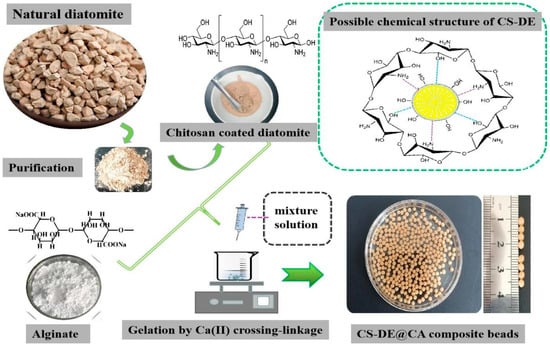
Scheme 1.
Schematic diagram methodology for chitosan-diatomite/calcium alginate composite beads.
2. Methods and Materials
2.1. Materials
The natural DE, whose main chemical components was crystal of SiO2, was obtained by Xuyang Co, Ltd. (Shijiazhuang, China). Chitosan (80–95%, degree of deacetylation), Congo red, sodium alginate (Na-alginate, loss on drying ≤ 22%), and calcium chloride were purchased from Sinopharm Chemical Reagent Co, Ltd. (Shanghai, China). Hydrochloric acid acetic acid was obtained from Lingfeng Co, Ltd. (Shanghai, China). All samples were prepared by the deionized (DI) water.
2.2. Purification of DE
At first, DE was ground into a powder and filtered through 200 mesh. The DE powder (20 g) was added into hydrochloric acid solution (2 mol/L, 500 mL) to remove organic and inorganic impurities. The mixture was stirred for 8 h with a magnetic stirrer at 200 rpm at room temperature. After filtration, the product was cleaned three times with deionized water and was then dried in an oven (100 °C).
2.3. Fabrication of CS-DE
CS (2 g) was dissolved in 100 mL acetic acid solution (2 wt.%) of DI and stirred until it was clear and transparent [29]. The DE (5 g) was added to the CS solution, and was then stirred until DE was evenly dispersed into the CS solution. After centrifugation for 5 min at 3000 rpm, and then static place for 12 h, the lower sediment (CS-DE) was dried in vacuum oven at 60 °C for 48 h.
2.4. Preparation of Hydrogel Beads
The obtained CS-DE (1 g) powders were added into sodium alginate solution (SA, 1 wt.%, 100 mL) and stirred at room temperature until evenly dispersed in alginate matrix solution. The hydrogel beads were prepared by extracting an equal volume of liquid (CS-DE@SA solution, 20 mL) using a injection pump (20 mL), and dropping it into CaCl2 (2%, 200 mL) solution, respectively. After curing for 12 h, the resulting product were taken out and washed for three times with deionized water to obtain the CS-DE@CA hydrogel beads. The obtained samples were dried for 48 h in a vacuum drier for character analysis, or were stored in distilled water for another test.
2.5. Characterization Methods
The FTIR of the obtained product was performed from 500 to 4000 cm−1 on a spectrometer (powdered samples in the KBr-disc form, Nicolet is10). X-ray diffraction (XRD) analysis of samples was carried out by the XRD Rint-2000 diffractometer. The morphologies and microstructure of the samples (Au coated) were observed on the Nova Nano SEM 230. The weight loss curve of the materials was performed on the Mettler Toledo analysis.
2.6. Adsorption Investigation
The batch adsorption experiment was investigated in different initial Congo red concentrations. The concentrations of the initial Congo red solutions were in the range of 25–150 mg/L at pH = 7. Therein, it was also ensured that adsorbents had contact with the aqueous solution. The adsorbed solution of different concentrations were determined by UV-vis spectroscopy (Jinghua, China) by measuring the absorbance at 497 nm [30]. The results were repeated three times and the average value was calculated to ensure accuracy of the obtained data.
The adsorption capacity of the beads was calculated by using the following Formula (1):
The removal efficiency of Congo red by adsorbent was calculated from each step and defined as (2):
where qt stands for the adsorption capacity of the sorbent for Congo red (mg/g), V is the volume of Congo red solution (L), and m is the sorbent mass (g), C0 and Ct are the concentration (mg/L) of Congo red at the initial and time t, respectively.
2.7. Regeneration Experiment
To further investigate the reusability of CS-DE@CA sorbent for Congo red adsorption, the desorption process experiments were carried out by the solutions of 0.1 mol/L NaOH. The pH value of aqueous solution was adjusted to 9 using NaOH solutions. An amount of 10 g of the wet adsorbed beads were added into the aqueous solution (temperature = 20 °C, 500 mL, pH = 9). After 24 h of elution, the regenerated CS-DE@CA beads were taken out and cleaned by a copious amount of DI water. The experiments were repeated at least three times. The adsorption–desorption–resorption process was subsequently evaluated in Congo red solution to study their reusability.
3. Results and Discussion
3.1. Characterization of the Samples
3.1.1. FT-IR and XRD Analysis
FT-IR was used for investigating the structural interactions and the existence of cross-linking on CS-DE@CA. Figure 1a shows the FT-IR spectra of the DE, CS-DE, and CS-DE@CA. The typical band around 801 cm−1 and 1070 cm−1 were due to-Si-O-Si-symmetric stretching occurred in all samples [31]. For CS-DE, the new characteristic absorption peaks at 2928 cm−1 and 2885 cm−1 occurred in CS-DE corresponding to stretching vibration of the C-H from chitosan carbon chains, indicating that CS probably was successfully introduced onto the surface of DE [32]. Furthermore, the new peak displayed at 1384 cm−1 referred to stretching vibrations of -CH3 groups, and several new amide characteristic peaks occurred in the range of 1515–1570 cm−1, which also confirmed that CS was probably coated on the surface of the DE [33,34]. The new peak of the CS-DE@CA near 1406 cm−1 was attributed to symmetric stretching vibrations of -COO−. The intensity of band in the range of 1515–1570 cm−1 obviously decreased and disappeared, which was possibly because of the COO- groups of alginate chains interacting with the protonated NH3+ groups of the CS by electrostatic interaction [34]. The absorption bands around 3600–3000 cm−1 were caused by the bending and stretching vibration of absorbed water, which overlapped with that of -OH at around 3567 cm−1 [35]. In addition, the gelation resulted in the broadening and migration of the CS-DE@CA spectrum (e.g., peaks around 1450, 1660, 3000–3600 cm−1 relative to raw DE), which can be attributed to the formation of hydrogen bonds between polymer substrates and Ca(II) ionic crosslinking [34].
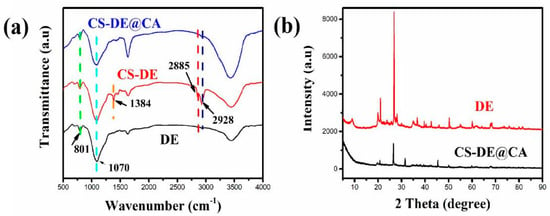
Figure 1.
(a) The FT−IR spectra of DE, CS−DE, and CS−DE@CA, (b) the XRD patterns of DE and CS−DE@CA.
Figure 1b shows XRD patterns results of raw DE and CS-DE@CA, respectively. In the patterns of raw DE, the diffraction angles of diatomite can be observed at near 20.68°, 26.58°, 36.64°, 50.73° [36]. The characteristic peaks of raw DE appeared in the XRD patterns of CS-DE@CA, which proved that the crystal phase structure of DE was generated and remained in the CS-DE@CA and they were successfully assembled.
3.1.2. SEM Analysis
SEM was employed to further explore the morphology and microstructure of DE, CS-DE, and CS-DE@CA beads, as displayed in Figure 2. It was observed that regular hollow and porous were uniformly distributed on the surface of DE (Figure 2a), which maybe provided more physical space for adsorption. Meanwhile, inherent pores were opened throughout with a diameter of approximately 100–200 nm, which could be convenient for dry molecules inside active sites of the adsorbent. Interestingly, from Figure 2b, we can clearly see that the coating of thin membrane and sheet structure were evenly dispersed on the surface of DE disks. It is possible that the silanol-rich DE surface with strong bonding to CS, and the ability can form porous and stable self-assembled monolayers [37]. Based on the obtained SEM images, we suggest that CS modifier was successfully coated onto the surface of DE. In addition, the selected EDX map showed that Si, O, C, and N were evenly distributed on the CS-DE (Figure 2c). This was because the CS mainly consisted of carbon, oxygen, and nitrogen elements in its molecule structure. The result of the outcome suggests a well-defined spatial distribution of CS on the DE. As for CS-DE@CA composite beads, it was found that the disk-like and columnar structures of DE particles were clearly immobilized on the surface of the hydrogel, which could be clearly observed in Figure 2d. The dispersion and interfacial compatibility of DE material in the hydrogel solved the agglomeration problem to some extent. In Figure 2e, it can be clearly seen that the beads shrank because of dehydration, and the final dried CS-DE@CA had a spherical structure with 1.2–1.8 mm.
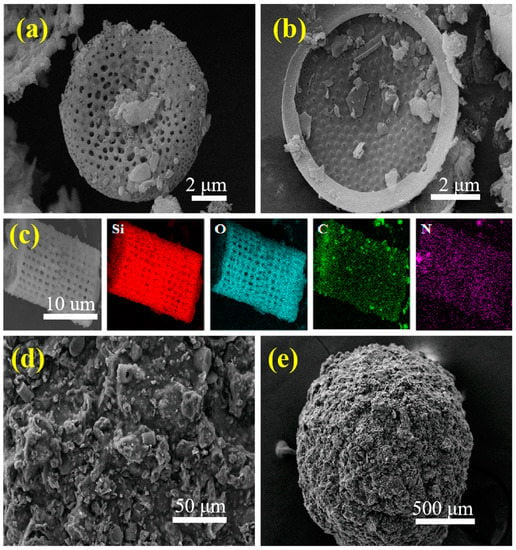
Figure 2.
SEM images of DE (a), CS-DE (b), element mapping images of Si, O, C, and N for CS-DE (c), and SEM images of CS-DE@CA (d,e).
3.1.3. TGA Analysis
TGA curves analysis was conducted to investigate the thermal stability of alginate matrix and the final CS-DE@CA beads. The TGA curves of the CA and the CS-DE@CA beads was performed under N2 flow with heating rate of 20 °C/min and up to 600 °C to study the thermal stability of the obtained sorbents. Figure 3 shows the TGA curves of CA, CS-DE@CA. In the range of 50–600 °C, the thermogravimetric loss of sorbent can be described in three stages (Table 1). Specifically, the first stage was about 50–150 °C, initial weight of CA beads loss approximately in 2.5–3%, and weight loss of CS-DE@CA beads about 1–1.5%, which could be caused the water evaporation from the beads. In the second degradation, a weight loss was found at 300 °C with weight loss of 28–30% for CA beads, and approximately 12–14% weight loss for CS-DE@CA beads, which was ascribed for the depolymerization and decomposition of C-O-C bonds of 1,4-linked glycosylic bonds of sorbent [38]. In the third stage, up to 600 °C, a weight loss of CA beads were about 38%-41%, and the approximately 23–25% for CS-DE@CA was observed, which may be attributed to the formation of carbonaceous materials [39]. The resulting analysis profiles of them suggested that thermal stability of the hydrogel beads were improved due to the presence of the clay materials, as previously reported with similar papers [40].
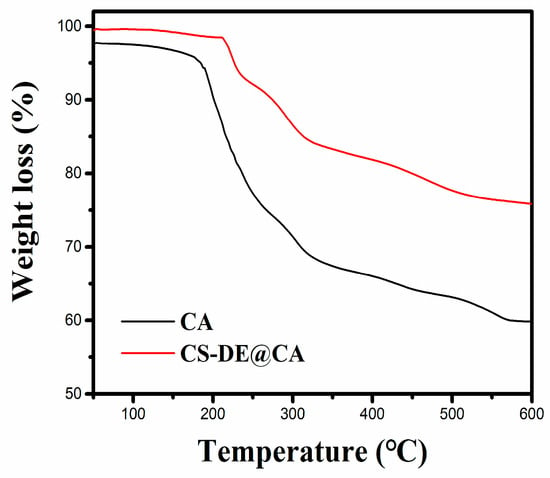
Figure 3.
TGA curves of CA and CS-DE@CA.

Table 1.
TGA data for different hydrogel beads.
3.2. Adsorption Studies
3.2.1. Adsorption Kinetics of CS-DE@CA Beads
In order to further investigate the special influence of adsorption process, the batch adsorption experiment was studied and evaluated by the following kinetic model [41]. Lagergren’s pseudo-first-order kinetics model presumes that the adsorption process is mainly controlled by physisorption process, while Ho’s pseudo-second-order kinetics model describes the adsorption process as occurring through chemisorption [42,43].
The pseudo-first order kinetic Formula (3):
The pseudo-second order kinetic Formula (4):
where qe represents adsorption capacity (mg/g) of Congo red in the equilibrium, and qt represents the adsorption capacity (mg/g) at time t (h). k1 (L/min) and k2 (g/mg.min) represent adsorption rate constants, respectively.
Adsorption kinetics analysis provides crucial information for the sorption process, and can be applied in assessing the removal efficiencies and adsorption capacity. The as-prepared samples (0.4 g, dry basis) were added into 100 mL Congo red solution, respectively. The adsorption performance was investigated through static adsorption method. Figure 4a shows the removal efficiencies of Congo red onto DE@CA and CS-DE@CA beads, respectively. DE@CA had the lower removal efficiencies (~83.6%) and CS-DE@CA had the higher removal efficiencies (~89.9%) after 180 h. One possible explanation is that by increasing the amount of effective-NH2 groups from the CS, these groups perhaps act as binding sites for the Congo red. The amine groups (-NH2) were easily protonated at neutral pH values, thus carrying a positive charge (-NH3+) [44]. Therefore, it is also possible that the adsorption process could have occurred and bound immediately through the strong electrostatic interactions between -NH3+ on the surface of beads and the negative charge of the -SO3− groups of Congo red, which was also consistent with similar previous works [45]. The previous works also deduced that the adsorption of Congo red on the CS-composite matrix occurred by H-bonding between the -OH groups of the adsorbent and the -NH2 groups of Congo red [46]. Additionally, their various functional groups on the surfaces adsorbent also seemed to a be major influence on their different adsorption performance, and was also consistent with similar to previous works for dye adsorption [47]. In the present study, the adsorption of Congo red was tested by using an aqueous solution containing concentrations of 25 mg/L, 50 mg/L, and 75 mg/L, respectively. The CS-DE@CA hydrogels beads (0.4 g, dry basis) were added to Congo red solution (500 mL) and the solutions were placed on a constant-temperature bath at 20 °C. As shown in (Figure 4b), results that the adsorption capacity also depended on the initial concentration of the Congo red in water. Remarkably, the adsorption capacity of the sample CS-DE@CA increased from 23.28 mg/g to 38.84 mg/g as the concentration of the Congo red in water increased from 25 mg/L to 75 mg/L after 384 h. In Figure 4c,d, the result revealed that the pseudo-second order kinetic model (R2 = 0.989–0.993) can better fit the experimental data than the pseudo-first order kinetic model (R2 = 0.921–0.981) toward the adsorption of Congo red. As a result, the above results indicated that the adsorption process of CS-DE@CA for Congo red was more consistent with chemical adsorption.
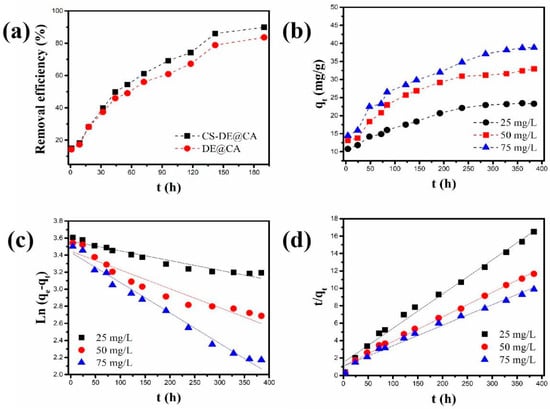
Figure 4.
The removal efficiencies of Congo red (temperature = 20 °C, 100 mL, 50 mg/L, and pH = 7) onto DE@CA and CS-DE@CA beads (a), the kinetics of Congo red (temperature = 20 °C, 500 mL, and pH = 7) onto the CS-DE@CA beads (b), the kinetic study of linear fitting of the pseudo-first and pseudo-second rate model (c,d).
The transmitting of the Congo red from aqueous solution to the surface of CS-DE@CA beads, of sorts, involved: adsorption on the bead surface, surface diffusion, external diffusion, and pore internal diffusion. At the beginning of contact time, the Congo red may transfer from the surface of samples to the the inner pores of the DE through intra-particle diffusion, which is generally a relatively slow proceeding. Additionally, the degree of suitability of CS-DE@CA beads towards Congo red can be evaluated by the following equation [48]:
in which Ki (mg g−1 min−1/2) is the rate constant of the intra-particle diffusion.
qt = Kit1/2 + c
c is the intercept, which is related to the thickness of the boundary layer.
Figure 5 shows the intra-particle diffusion kinetics of Congo red onto CS-DE@CA beads at the different concentrations. The intra-particle diffusion is possibly affected by different elements including the concentration of the solution, the degree of mixing, the size of the adsorbents and its chelating for the molecule, and so on [49]. In comparison with the values (R2 = 0.989–0.993) of pseudo-second-order model, the obtained values (R2 = 0.962–0.986) by intra-particle diffusion kinetic model were slightly low.
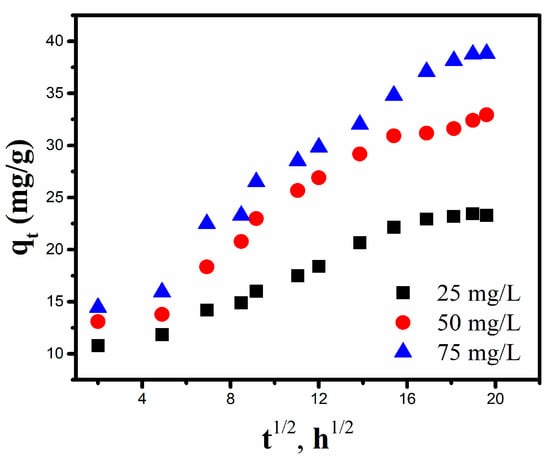
Figure 5.
The intra-particle diffusion kinetics of Congo red onto CS-DE@CA beads at the different concentrations.
3.2.2. The Isotherm Study of CS-DE@CA Beads
In order to further evaluate the adsorption effect of CS-DE@CA for Congo red, Langmuir and Freundlich isotherm models were used to fit the collected experiment parameter. Langmuir (equation) and Freundlich (equation) adsorption isotherm models are as follows [50]:
Kf (L/mg) was the separation factor, equilibrium adsorption constant of Langmuir, qm was the maximum monolayer coverage capacity (mg/g), Ce was the concentration (mg/L) of the equilibrium, qe adsorption capacity (mg/g) at equilibrium of the two models. 1/n was the intensity factor.
The Langmuir isotherm model assumes that each binding reactive site can cover one molecule of Congo red. The Freundlich isotherm model assumes that the adsorption occurs on the heterogeneous adsorbent surface and that also allows multilayer adsorption [51]. Figure 6 showed the adsorption equilibrium isotherm of Congo red onto CS-DE@CA at temperature 20 °C: Langmuir and Freundlich isotherm fitting curve.
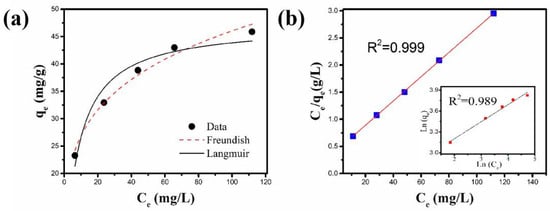
Figure 6.
The fitting curve of the Langmuir and Freundlich models (a), and Langmuir and Freundlich isotherm models for the Congo red adsorption onto CS-DE@CA beads (b).
The relevant evaluation of Langmuir and Freundlich models were fabricated as tabulated in Table 2. It was depicted that the linearized correlation coefficient (R2 = 0.999) of the Langmuir adsorption model was better than that (R2 = 0.989) of the Freundlich adsorption model, indicating that the adsorption of Congo red by CS-DE@CA beads was more suitable for the Langmuir adsorption isotherm model, and the monolayer adsorption played a major role. The maximum adsorption capacity of CS-DE@CA beads was calculated to 48.42 mg/g for Congo red by Langmuir model. The actual experimental adsorption capacity was about 47.62 mg/g. Therefore, that has potential application for wastewater purification management.

Table 2.
Langmuir and Freundlich adsorption isotherm model parameters for the adsorption of Congo red onto CS-DE@CA at 20 °C.
Accordingly, the maximum adsorption capacity of CS-DE@CA for Congo red can be calculated as 48.42 mg/g. Compared with the previously reported results, the adsorption capacity of Congo red by CS-DE@CA beads was at a medium level (Table 3). Although some other adsorbents can remove Congo red, their composition is toxic to human and aquatic life, and they may give rise to secondary contaminate of the water environment. Additionally, some powder adsorbents are difficult to collect from aqueous solution and also pose the risk of re-release of Congo red to water body. Considering the abundant raw material reserves of CS-DE@CA and the facile preparation process, the new-type sorbent was a promising purifier for Congo red in wastewater treatment.

Table 3.
Compare the adsorption properties of materials for removal of Congo red.
3.3. Regeneration Experiment
The analysis of regeneration process was of great significance in practical application of the adsorbent. Figure 7 showed the relationship between the adsorption capacity and the number of reuses. On each cycle, there was a decrease in the adsorption capacity of CS-DE@CA. After four adsorption–desorption cycles experiments, its performance slightly decreased, but the CS-DE@CA materials still maintained excellent adsorption capacity with ~35 mg/g. The experiments data demonstrated the successful reusability of CS-DE@CA beads. To be more specific, the CS-DE@CA beads not only have excellent reusable lines, but also can be easily separated by gravity and have potential industrial application.
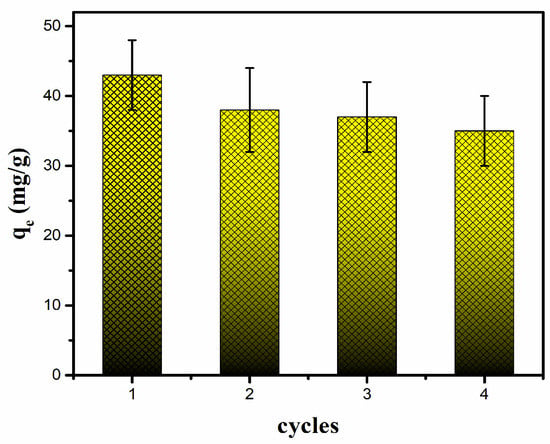
Figure 7.
Recyclability performance of the CS-DE@CA composite beads for Congo red.
3.4. Adsorption Mechanism Analysis
The possible adsorption mechanisms of Congo red is illustrated in Scheme 2. The interaction between Congo red molecules and adsorbent was dominated by physical behavior (such as pore-filling mechanism) and chemical interactions (such as electrostatic attraction, π–π interactions, etc.) [58].
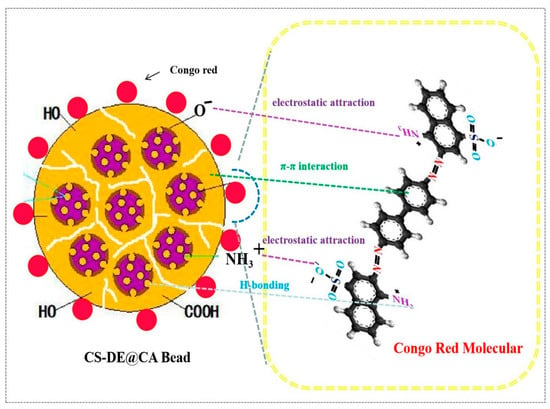
Scheme 2.
Proposed mechanism for Congo red removal by CS-DE@CA composite beads.
On the one hand, the DE had a relatively regular skeleton structure and effective porosity, which providing more physical space for adsorption. The dye molecules can easily diffuse and disperse inside the sorbent by pore structure, thus adsorbing faster on the adsorbent. On the other hand, some researchers proposed that adsorption of Congo red occur onto the surface by electrostatic attraction [59]. Congo red is a water-soluble anionic azo dye, the molecules structure were generally negatively charged. The amino groups (-NH2) in Congo red molecules could be protonated and carry a positive charge (-NH3+). Therefore, the strong electrostatic attraction can also occur between the protonated-NH3+ and the adsorbent surface that was negatively charged [6,60]. Moreover, Congo red molecules structure have aromatic rings; thus, the rings also can interact with carbon composites through π–π attraction [61]. The employment of CS as a modifier may improve their adsorption capability for Congo red on account of its abundant hydroxyl and amine groups, through electrostatic attraction and π–π interaction to produce interactions. According to the mentioned possibilities, these interactions and their synergistic effects between Congo red molecules and adsorbents facilitate the adsorption process of Congo red molecules on the surface of the as-prepared CS-DE@CA composite beads.
4. Conclusions
In this study, we successfully prepared novel composite hydrogel beads CS-DE@CA for the adsorption of Congo red. The successful surface-modification of the clay DE and the corresponding cross-linked alginate hydrogels were confirmed by using FTIR, SEM, and TGA techniques. The fillers of CS-functionalized DE imparted to the hydrogel beads a satisfactorily effective removal rate for Congo red. The assessment of adsorption performance of the CS-DE@CA beads showed the maximum adsorption capacity with 48.42 mg/g. Additionally, the investigations of adsorption kinetic and isotherm revealed that the Congo red removal from aqueous solution was mainly controlled by chemical adsorption, best fitted into Langmuir isotherm models. The good regenerative performance demonstrated its potential application for wastewater management. Taken together, our work hereby paves a promising and efficient strategy to design advanced functional water purifier contributing to address the global environmental problem.
Author Contributions
D.Z., conceptualization, formal analysis, methodology, writing—original draft, validation, software, investigation, data curation, writing—review and editing; X.S., investigation, visualization, validation, project administration. All authors have read and agreed to the published version of the manuscript.
Funding
The authors gratefully acknowledge the financial support from the Sinopec Wuhan Corporation (102049).
Data Availability Statement
The datasets used and/or analyzed during the current study are available from the corresponding author on reasonable request.
Conflicts of Interest
The authors declare that they have no known competing financial interests or personal relationships that could have appeared to influence the work reported in this paper.
References
- Gharib, A.; Blumberg, J.; Manning, D.; Goemans, C.; Arabi, M. Assessment of vulnerability to water shortage in semi-arid river basins: The value of demand reduction and storage capacity. Sci. Total Environ. 2023, 871, 161964. [Google Scholar] [CrossRef] [PubMed]
- Pramanik, A.; Gates, K.; Gao, Y.; Zhang, Q.; Han, F.; Begum, S.; Rightsell, C.; Sardar, D.; Ray, C. Composites Composed of Polydopamine Nanoparticles, Graphene Oxide, and ε-Poly-l-lysine for Removal of Waterborne Contaminants and Eradication of Superbugs. ACS Appl. Energy Mater. 2019, 2, 3339–3347. [Google Scholar] [CrossRef]
- Cui, M.; Li, Y.; Sun, Y.; Wang, H.; Li, M.; Li, L.; Xu, W. Study on Adsorption Performance of MgO/Calcium Alginate Composite for Congo Red in Wastewater. J. Polym. Environ. 2021, 29, 3977–3987. [Google Scholar] [CrossRef]
- Huang, W.; Yu, C.; Li, D. La-modified vermiculites for efficient adsorption of Congo red. Asia-Pac. J. Chem. Eng. 2017, 12, 969–979. [Google Scholar] [CrossRef]
- Vignesh, V.; Shanmugam, G. Removal and recovery of hazardous Congo red from aqueous environment by selective natural amino acids in simple processes. Process Biochem. 2023, 127, 99–111. [Google Scholar] [CrossRef]
- Zheng, Y.; Cheng, B.; Fan, J.; Yu, J.; Ho, W. Review on Nickel-based adsorption materials for Congo red. J. Hazard. Mater. 2020, 403, 123559. [Google Scholar] [CrossRef]
- Wang, J.; Chen, H. Catalytic Ozonation for Water and Wastewater Treatment: Recent Advances and Perspective. Sci. Total Environ. 2020, 704, 135249. [Google Scholar] [CrossRef]
- Liu, J.; Wang, N.; Zhang, H.; Baeyens, J. Adsorption of Congo red dye on FexCo3-xO4 nanoparticles. J. Environ. Manag. 2019, 238, 473–483. [Google Scholar] [CrossRef]
- McYotto, F.; Wei, Q.; Macharia, D.; Huang, M.; Shen, C.; Chow, C. Effect of dye structure on color removal efficiency by coagulation. Chem. Eng. J. 2021, 405, 126674. [Google Scholar] [CrossRef]
- Li, K.; Yuan, G.; Dong, L.; Deng, G.; Duan, H.; Jia, Q.; Zhang, H.; Zhang, S. Boehmite aerogel with ultrahigh adsorption capacity for Congo Red removal: Preparation and adsorption mechanism. Sep. Purif. Technol. 2022, 202, 122065. [Google Scholar] [CrossRef]
- Son, D.; Mai, Q.; Du, X.; Phong, H.; Cuong, D.; Khieu, Q. Catalytic wet peroxide oxidation of phenol solution over Fe-Mn binary oxides diatomite composite. J. Porous Mater. 2017, 24, 601–611. [Google Scholar] [CrossRef]
- Song, J.; Cao, X.; Huang, Z. Diatomite-chitosan composite with abundant functional groups as efficient adsorbent for vanadium removal: Key influencing factors and influence of surface functional groups. J. Mol. Liq. 2022, 367, 120428. [Google Scholar] [CrossRef]
- Chang, J.; Zhang, J.; Tan, B.; Wang, Q.; Liu, N.; Xue, Q. New insight into the removal of Cd(II) from aqueous solution by diatomite. Environ. Sci. Pollut. Res. 2020, 27, 9882–9890. [Google Scholar] [CrossRef] [PubMed]
- Vishal, K.; Aruchamy, K.; Sriram, G.; Ching, Y.; Oh, T.; Hegde, G.; Ajeya, K.; Joshi, S.; Sowriraajan, A.; Jung, H.; et al. Engineering a low-cost diatomite with Zn-Mg-Al Layered triple hydroxide (LTH) adsorbents for the effectual removal of Congo red: Studies on batch adsorption, mechanism, high selectivity, and desorption. Colloids Surf. A 2023, 661, 130922. [Google Scholar] [CrossRef]
- Wang, B.; Xiong, M.; Shi, B.; Li, Z.; Zhang, H. Treatment of shale gas flowback water by adsorption on carbonnanotube-nested diatomite adsorbent. J. Water Process Eng. 2021, 42, 102074. [Google Scholar] [CrossRef]
- Shen, W.; An, Q.; Xiao, Z.; Zhai, S.; Hao, J.; Tong, Y. Alginate modified graphitic carbon nitride composite hydrogels for efficient removal of Pb(II), Ni(II) and Cu(II) from water. Int. J. Biol. Macromol. 2020, 147, 1298–1306. [Google Scholar] [CrossRef]
- Xi, H.; Li, Q.; Yang, Y.; Zhang, J.; Guo, F.; Wang, X.; Xu, S.; Ruan, S. Highly effective removal of phosphate from complex water environment with porous Zr-bentonite alginate hydrogel beads: Facile synthesis and adsorption behavior study. Appl. Clay Sci. 2021, 201, 105919. [Google Scholar] [CrossRef]
- Liang, S.; Cai, W.; Dang, C.; Peng, X.; Luo, Z.; Wei, X. Synthesis of sodium alginate/phosphorus tetramethylmethyl sulfate biocomposite beads with exceptional adsorption rate for Cr(VI) removal. J. Environ. Chem. Eng. 2023, 11, 109317. [Google Scholar] [CrossRef]
- Zhang, Y.; Yang, Y.; Zhao, X.; Gao, J. Investigation on ionical cross-linking of alginate by monovalent cations to fabrication alginate gel for biomedical application. React. Funct. Polym. 2023, 183, 105484. [Google Scholar] [CrossRef]
- Godiya, C.; Xiao, Y.; Lu, X. Amine functionalized sodium alginate hydrogel for efficient and rapid removal of methyl blue in water. Int. J. Biol. Macromol. 2020, 144, 671–681. [Google Scholar] [CrossRef]
- Xiao, Z.; Zhang, L.; Wu, L.; Chen, D. Adsorptive removal of Cu(II) from aqueous solutions using a novel macroporous bead adsorbent based on poly(vinyl alcohol)/sodium alginate/KMnO4 modified biochar. J. Taiwan Inst. Chem. Eng. 2019, 102, 110–117. [Google Scholar] [CrossRef]
- Pereira, A.; Rodrigues, F.; Paulino, A.; Martins, A.; Fajardo, A. Recent advances on composite hydrogels designed for the remediation of dye-contaminated water and wastewater: A review. J. Clean. Prod. 2021, 284, 124703. [Google Scholar] [CrossRef]
- Zhao, D.; Shen, Z.; Shen, X. Dual-functional calcium alginate hydrogel beads for disinfection control and removal of dyes in water. Int. J. Biol. Macromol. 2021, 188, 253–263. [Google Scholar] [CrossRef]
- Fan, D.; Zhu, X.; Xu, M.; Yan, J. Adsorption Properties of Chromium (VI) by Chitosan Coated Montmorillonite. J. Biol. Sci. 2006, 6, 941–945. [Google Scholar]
- Wan, M.W.; Kan, C.C.; Rogel, B.D.; Dalida, M.L.P. Adsorption of Copper(II) and Lead(II) Ions from Aqueous Solution on Chitosan-Coated Sand. Carbohydr. Polym. 2010, 80, 891–899. [Google Scholar] [CrossRef]
- Futalan, C.M.; Kan, C.C.; Dalida, M.L.; Hsien, K.J.; Pascua, C.; Wan, M.W. Comparative and Competitive Adsorption of Copper, Lead, and Nickel Using Chitosan Immobilized on Bentonite. Carbohydr. Polym. 2011, 83, 528–536. [Google Scholar] [CrossRef]
- Boddu, V.M.; Abburi, K.; Randolph, A.J.; Smith, E.D. Removal of copper(II) and nickel (II) ions from aqueous solutions by a composite chitosan biosorbent. Sep. Sci. Technol. 2008, 43, 1365–1380. [Google Scholar] [CrossRef]
- Mokhtari, A.; Mohammad, S.; Hamidrez, A. 3D porous bioadsorbents based on chitosan/alginate/cellulose nanofibers as efficient and recyclable adsorbents of anionic dye. Carbohydr. Polym. 2021, 265, 118075. [Google Scholar] [CrossRef]
- Wang, F.; Gao, J.; Jia, L.; Wang, S.; Ning, P. Green synthesis of a novel functionalized chitosan adsorbent for Cu(II) adsorption from aqueous solution. Environ. Sci. Pollut. Res. 2022, 29, 989–998. [Google Scholar] [CrossRef]
- Wang, P.; Tan, L.; Yuan, G.; Feng, S.; Tang, H.; Wang, G.; Wang, C. ZIF-8 modified polyvinyl alcohol/chitosan composite aerogel for efficient removal of Congo red. J. Solid State Chem. 2022, 316, 123628. [Google Scholar] [CrossRef]
- Lva, J.; Sun, B.; Jin, J.; Jiang, W. Mechanical and slow-released property of poly(acrylamide) hydrogel reinforced by diatomite. Mater. Sci. Eng. C-Mater. Biol. Appl. 2019, 99, 315–321. [Google Scholar] [CrossRef] [PubMed]
- Biao, L.; Tan, S.; Wang, Y.; Guo, X.; Fua, Y.; Xu, F.; Zu, Y.; Liu, Z. Synthesis, characterization and antibacterial study on the chitosan-functionalized Ag nanoparticles. Mater. Sci. Eng. C-Mater. Biol. Appl. 2017, 76, 73–80. [Google Scholar] [CrossRef] [PubMed]
- Alam, M.; Christopher, L. Natural Cellulose-Chitosan Cross-Linked Super absorbent Hydrogels with Superior Swelling Properties. ACS Sustain. Chem. Eng. 2018, 6, 8736–8742. [Google Scholar] [CrossRef]
- Zhang, W.; Wang, H.; Hu, X.; Feng, H.; Xiong, W.; Guo, W.; Zhou, J.; Mosa, A.; Peng, Y. Multicavity triethylenetetramine-chitosan/alginate composite beads for enhanced Cr(VI) removal. J. Clean. Prod. 2019, 231, 733–745. [Google Scholar] [CrossRef]
- Zhang, Q.; Zhu, Y.; Wu, J.; Shao, Y.; Cai, A.; Dong, L. Ultralong Hydroxyapatite Nanowire-Based Filter Paper for High-Performance Water Purification. ACS Appl. Mater. Interfaces 2019, 11, 4288–4301. [Google Scholar] [CrossRef]
- Li, X.; Zhang, X.; Xu, Y.; Yu, P. Removal of nitrobenzene from aqueous solution by using modified magnetic diatomite. Sep. Purif. Technol. 2020, 242, 116792. [Google Scholar] [CrossRef]
- Chen, Z.; Jiang, J.; Yu, Y.; Zhang, Q.; Chen, T.; Ni, L. Layer-by-layer assembled diatomite based on chitosan and ammonium polyphosphate to increase the fire safety of unsaturated polyester resins. Powder Technol. 2020, 364, 36–48. [Google Scholar] [CrossRef]
- Sanchez, L.; Alvarez, V.; Ollier, R. Acid-treated Bentonite as filler in the development of novel composite PVA hydrogels. J. Appl. Polym. Sci. 2019, 136, 47663. [Google Scholar] [CrossRef]
- Lessa, E.; Gularte, M.; Garcia, E.; Fajardo, A. Orange waste: A valuable carbohydrate source for the development of beads with enhanced adsorption properties for cationic dyes. Carbohydr. Polym. 2017, 157, 660–668. [Google Scholar] [CrossRef]
- Shehzad, H.; Ahmed, E.; Sharif, A.; Din, M.; Farooqi, Z.; Nawaz, I.; Bano, R.; Iftikhar, M. Amino-carbamate moiety grafted calcium alginate hydrogel beads for effective biosorption of Ag(I) from aqueous solution: Economically-competitive recovery. Int. J. Biol. Macromol. 2020, 144, 362–372. [Google Scholar] [CrossRef]
- Varaprasad, K.; Nùñez, D.; Ide, W.; Jayaramudu, T.; Sadiku, E. Development of high alginate comprised hydrogels for removal of Pb(II) ions. J. Mol. Liq. 2020, 298, 112087. [Google Scholar] [CrossRef]
- Liu, X.; Zhou, X.; Yin, J.; He, C.; Zhao, W.; Zhao, C. Fast and environmental-friendly approach towards uniform hydrogel particles with ultrahigh and selective removal of anionic dyes. J. Environ. Chem. Eng. 2020, 8, 104352. [Google Scholar] [CrossRef]
- Yap, P.; Auyoong, Y.; Hassan, K.; Farivar, F.; Tran, D.; Mab, J.; Losic, D. Multithiol functionalized graphene bio-sponge via photoinitiated thiol-ene click chemistry for efficient heavy metal ions adsorption. Chem. Eng. J. 2020, 395, 124965. [Google Scholar] [CrossRef]
- Yiğitoğlu, M.; Temocin, Z. Removal of Benzidine-Based Azo Dye from Aqueous Solution using Amide and Amine-Functionalized Poly(ethylene terephthalate) Fibers. Fibers Polym. 2010, 11, 996–1002. [Google Scholar] [CrossRef]
- Aoopngan, C.; Nonkumwong, J.; Phumying, S.; Promjantuek, S.; Maensiri, S.; Noisa, P.; Pinitsoontorn, S.; Ananta, S.; Srisombat, L. Amine-Functionalized and Hydroxyl-Functionalized Magnesium Ferrite Nanoparticles for Congo Red Adsorption. ACS Appl. Nano Mater. 2019, 2, 5329–5341. [Google Scholar] [CrossRef]
- Hou, H.; Zhou, R.; Wu, P.; Wu, L. Removal of Congo Red Dye from Aqueous Solution with Hydroxyapatite/Chitosan Composite. Chem. Eng. J. 2012, 211–212, 336–342. [Google Scholar] [CrossRef]
- Mahmoodi, N.; Khorramfar, S.; Najafi, F. Amine Functionalized Silica Nanoparticle: Preparation, Characterization and Anionic Dye Removal Ability. Desalination 2011, 279, 61–68. [Google Scholar] [CrossRef]
- Yi, X.; Sun, F.; Han, Z.; Han, F.; He, J.; Ou, M.; Gu, J.; Xu, X. Graphene oxide encapsulated polyvinyl alcohol/sodium alginate hydrogel microspheres for Cu (II) and U (VI) removal. Ecotoxicol. Environ. Saf. 2018, 158, 309–318. [Google Scholar] [CrossRef]
- Luo, X.; Lei, X.; Cai, N.; Xie, X.; Xue, Y.; Yu, F. Removal of Heavy Metal Ions from Water by Magnetic Cellulose Based Beads with Embedded Chemically Modified Magnetite Nanoparticles and Activated Carbon. ACS Sustain. Chem. Eng. 2016, 4, 3960–3969. [Google Scholar] [CrossRef]
- Kim, H.; Im, S.; Kim, J.; Hong, W.; Shin, K.; Jeong, H.; Hong, Y. Phytic Acid Doped Polyaniline Nanofibers for Enhanced Aqueous Copper(II) Adsorption Capability. ACS Sustain. Chem. Eng. 2017, 5, 6654–6664. [Google Scholar] [CrossRef]
- Li, W.; Wei, H.; Liu, Y.; Li, S.; Wang, G.; Guo, T.; Han, H. An in situ reactive spray-drying strategy for facile preparation of starch-chitosan based hydrogel microspheres for water treatment application. Chem. Eng. Process. 2021, 168, 108548. [Google Scholar] [CrossRef]
- Hai, Y.; Li, X.; Wu, H.; Zhao, S.; Deligeer, W.; Asuha, S. Modification of acid-activated kaolinite with TiO2 and its use for the removal of azo dyes. Appl. Clay Sci. 2015, 114, 558–567. [Google Scholar] [CrossRef]
- Kumar, R.; Ansari, S.; Barakat, M.; Aljaafari, A.; Cho, M. A polyaniline@MoS2- based organic-inorganic nanohybrid for the removal of Congo red: Adsorption kinetic, thermodynamic and isotherm studies. New J. Chem. 2018, 42, 18802–18809. [Google Scholar] [CrossRef]
- Eniola, J.; Kumar, R.; Al-Rashdi, A.; Ansari, M.; Barakat, M. Fabrication of novel Al(OH)3/CuMnAl-layered double hydroxide for detoxification of organic contaminants from aqueous solution. ACS Omega 2019, 4, 18268–18278. [Google Scholar] [CrossRef]
- Harja, M.; Buema, G.; Bucur, D. Recent advances in removal of Congo Red dye by adsorption using an industrial waste. Sci. Rep. 2022, 12, 6087. [Google Scholar] [CrossRef] [PubMed]
- Mahmoud, M.; Amira, M.; Azab, M.; Abdelfattah, A. An innovative amino-magnetite@graphene oxide@amino-manganese dioxide as a nitrogen-rich nanocomposite for removal of Congo red dye. Diam. Relat. Mater. 2022, 121, 108744. [Google Scholar] [CrossRef]
- Alsoaud, M.; Taher, M.; Hamed, A.; Elnouby, M.; Omer, A. Reusable kaolin impregnated aminated chitosan composite beads for efficient removal of Congo red dye: Isotherms, kinetics and thermodynamics studies. Sci. Rep. 2022, 12, 12972. [Google Scholar] [CrossRef]
- Radjai, M.; Ferkous, H.; Jebali, Z.; Majdoub, H.; Bourzami, R.; Raffin, G.; Achour, M.; Gil, A.; Boutahala, M. Adsorptive removal of cationic and anionic dyes on a novel mesoporous adsorbent prepared from diatomite and anionic cellulose nanofibrils: Experimental and theoretical investigations. J. Mol. Liq. 2022, 361, 119670. [Google Scholar] [CrossRef]
- Wang, L.; Li, J.; Wang, Y.; Zhao, L.; Jiang, Q. Adsorption capability for Congo red on nanocrystalline MFe2O4 (M = Mn, Fe, Co, Ni) spinel ferrites. Chem. Eng. J. 2012, 181, 72–79. [Google Scholar] [CrossRef]
- Feng, T.; Wang, H.; Xu, J.; Du, X.; Cheng, X.; Du, Z.; Wang, H. Fabrication of MXene/PEI functionalized sodium alginate aerogel and its excellent adsorption behavior for Cr(VI) and Congo Red from aqueous solution. J. Hazard. Mater. 2021, 416, 125777. [Google Scholar] [CrossRef]
- Zong, E.; Fan, R.; Hua, H.; Yang, J.; Jiang, S.; Dai, J.; Liu, X.; Song, P. A magnetically recyclable lignin-based bio-adsorbent for efficient removal of Congo red from aqueous solution. Int. J. Biol. Macromol. 2023, 226, 443–453. [Google Scholar] [CrossRef] [PubMed]
Disclaimer/Publisher’s Note: The statements, opinions and data contained in all publications are solely those of the individual author(s) and contributor(s) and not of MDPI and/or the editor(s). MDPI and/or the editor(s) disclaim responsibility for any injury to people or property resulting from any ideas, methods, instructions or products referred to in the content. |
© 2023 by the authors. Licensee MDPI, Basel, Switzerland. This article is an open access article distributed under the terms and conditions of the Creative Commons Attribution (CC BY) license (https://creativecommons.org/licenses/by/4.0/).